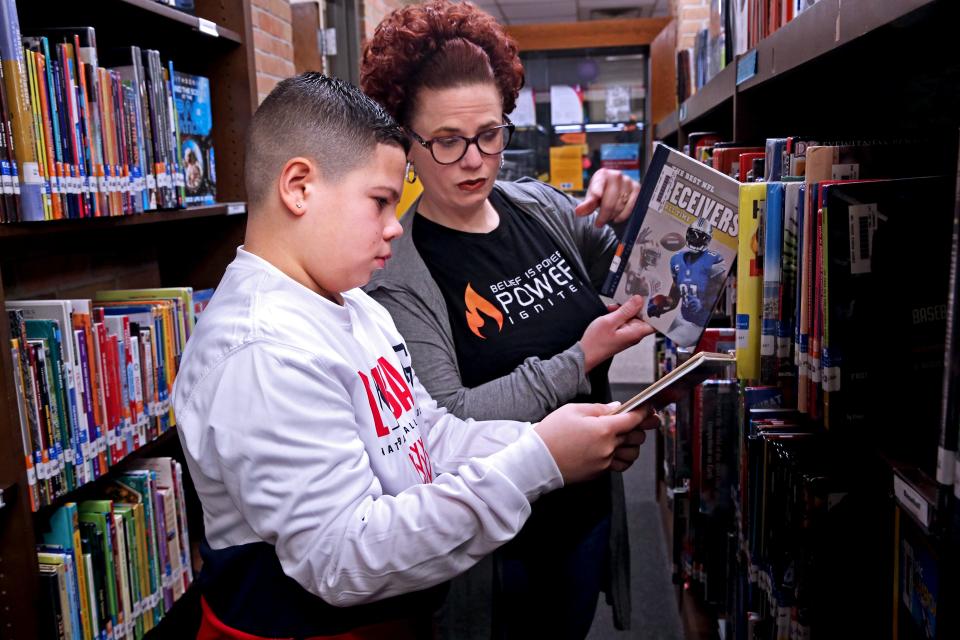Cudahy’s move to science of reading curriculum hasn’t been easy, but test scores are encouraging
A shift toward using “science of reading” curriculums that emphasize phonics in teaching students to read is occurring in Wisconsin and across the nation. This is the second of three columns describing what this means to students, educators and parents in Cudahy Public Schools, which has embraced this approach.
More: Cudahy Schools' shift to a new reading curriculum looks like it's paying off
Kari Durr-Castillo remembers getting “that phone call” that no parent wants to get. Her son, Alejandro Castillo, then in third grade, had struggled with reading since he began school.
She remembers teachers assuring her that things would work out for him. She was told to get him books about things he liked. But, she said, “he just wasn’t liking it (reading).” A sociable student, he found ways to joke around when called on and to get others to take his turns at reading or help him with assignments.

Finally, she and her husband were asked to come in for a meeting, and they agreed to have an evaluation done to see whether Alejandro had special education needs. He was far below where he was supposed to be in some areas. and he began receiving extra help. Then the COVID pandemic started, and things were thrown off track.
But starting in the 2021-22 school year, Alejandro got involved in the structured and phonics-oriented reading program that was beginning at his school, Kosciuszko Elementary in Cudahy. Durr-Castillo said it took some time, but she saw that he was making progress. Then, all of a sudden, she said, he was telling her, ”You should see my scores.” She went on the school’s online program for tracking student progress. “I opened it up, and I’m like, wow, you did really good.”
He was meeting his goals, she said, and enjoying what he was doing. And then came his results on Wisconsin’s Forward tests from spring 2022. “I got those results shortly before he was going into sixth grade, and he actually was proficient in his reading,” Durr-Castillo said. “I was just kind of taken aback, I’ll tell you.” She double checked to make sure she wasn’t looking at her daughter’s report.

The progress continued into the current school year, so much so that Alejandro’s special education status was dropped recently.
Durr-Castillo is on the Cudahy School Board. She has become a firm supporter of using the science of reading approach. A lot of other parents have seen similar results for their children, she said.
“I hear it all over the place,” she said. “It’s super popular in the community. ... The ones who were struggling the hardest are the ones who are breaking through the most.”
Crystal Silkwood is a school parent who worked as a substitute teacher until she was elected to the Cudahy School Board in 2022. Her twin sons are in 5-year-old kindergarten at Kosciuszko School and in their second year of being taught using the science of reading approach.
More: A bipartisan consensus could be growing on how to teach reading statewide
Silkwood said that at first, her sons said they hated the reading instruction. They said it was long and boring and too fast. It made their brains hurt.
But then she saw they were doing things at home that they learned in school. “They would do it all day long; they would walk around going, ‘cat, bat, rat.’” They were figuring out words on their own. “It really increased their desire to know about letters and how to spell things,” she said.
One day, the family was in their car at a stoplight when one son read the words on a sign for a restaurant. “I was like, wow, you’re basically reading,” Silkwood said. “My kids seem to be well on their way.”
“They really seem to be progressing quickly, which is exciting, even though they say they hate it,” she added. Overall, she said, ”It’s going shockingly well. Their progress, to me, went from zero to 100 really, really quickly.”
As for the teachers she worked with when she was substituting while the science reading was being introduced, Silkwood said, “I do know that the teachers — and me — when they first rolled it out, were like, what is this? There was a lot of resistance at the school. But they did it, they tried it ... and it’s just, like, extremely effective.”
Cudahy test scores are encouraging
Critics of the science of reading, such as Professor Paul Thomas of Furman University in South Carolina, say that support for the phonics-strong approach is long on anecdotes and short on broad results.
Overall, the jury is out; neither balanced literacy nor the science of reading have large-scale records of big increases in reading success. In education, change so often comes incrementally, if it comes at all. In the case of reading, scores nationwide improved slightly over the last couple decades — but those gains were erased during the pandemic.
More: By the Book: We're investigating why many Wisconsin kids struggle to read. We want to hear from you.
Advocates for the science of reading say that, overall, things are early in the big picture of the process of implementation. Broad results won’t be clear for at least several years. And, as is true with so many things, the quality of the work — often called “fidelity” in education circles — matters a lot, as does having adequate resources. Not all schools are doing the work as well as others or have had the benefit of good planning and implementation.
Some states where the phonics-strong approach has been implemented have shown improvement — or at least saw declines through the pandemic period that were less than elsewhere. Mississippi and Thomas’ own state, South Carolina, are on such lists. And many schools and school districts say they are seeing good — or at least promising — signs of improvement.
Count Cudahy on that list. There is still much need for improvement. But school leaders see encouraging signs.

Superintendent Tina Owen-Moore said that Cudahy third-graders improved their scores on the state reading tests from spring 2021 to spring 2022 by 6.5%, which was above the state average. (Spring 2023 results will not be released until this fall.)
She also provided data from internal measures of progress used in Cudahy that showed that in each of the district’s elementary schools, the percentage of students considered “high risk” for not becoming capable readers had decreased, and the number considered “low-risk/college pathway” had increased.
The Cudahy district as a whole currently has about 2,100 students. About 60% are considered “economically disadvantaged.” The student body overall is about 52% white, 28% Hispanic, 9% Black, and 8% of two or more races or ethnic groups.
Among Cudahy third-graders overall, in spring 2019, 35.9% were rated proficient or advanced in English language arts and reading on Wisconsin’s Forward tests, and 19.7% were rated as below basic. In spring 2022, 28.8% were rated proficient or advanced, 7.1 percentage points below the 2019 figure, and 22.7% were below basic, a three-point increase.
But the comparison to the percentages from 2021 (the first round of tests after big pandemic disruptions) and from 2022 showed considerable improvement. For example, in 2021, 27% were “below basic” in reading, and in 2022, the figure was 22.7%, an improvement of more than four points.
For 2022, among Cudahy third- through eighth-grade students, 28.1% were proficient or advanced, and 34.1% were below basic. For Wisconsin third- through eighth-graders overall, 37% were proficient or advanced and 26.1% were below basic.
For many years, Cudahy — and a large number of other school districts in Wisconsin — made few changes in their overall approach to teaching reading, despite large numbers of students falling short of proficiency levels.
But don’t past reading results provide good reason to try something different? Cudahy school leaders say yes. So they are, with early signs of improvement, a long way to go, but a commitment to keep pushing for better.
Next: More than just phonics – a look at other aspects of what the science of reading approach is bringing to Cudahy schools.
Alan J. Borsuk is senior fellow in law and public policy at Marquette Law School. Reach him at alan.borsuk@marquette.edu.
Our subscribers make this reporting possible. Please consider supporting local journalism by subscribing to the Journal Sentinel at jsonline.com/deal.
DOWNLOAD THE APP: Get the latest news, sports and more
This article originally appeared on Milwaukee Journal Sentinel: Reading test scores improving in Cudahy under new program

